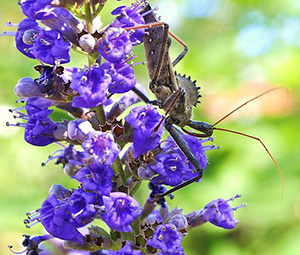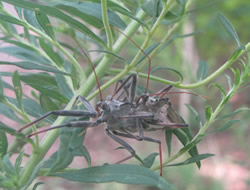Wheel Bug (Arilus cristatus)
Wheel Bug (Arilus cristatus)
By Bill Willis, NIEHS Wildlife and Industry Together (WAIT)
December, 2015
Little Known & Lesser Seen: An Insect that Kills for a Living

Jeffrey W
Most of us are familiar with many of the predatory insects that live in our environment. Well known ones include the Praying Mantis and the Lady Beetle, both of which are important in controlling plant pests. But, there is another, just as interesting, insect that you may have missed on campus: the Wheel bug (Arilus cristatus), a member of the Assassin bug family (Reduviidae).
The Wheel bug truly lives up to both of its names. Its primary name comes from the saw like wheel structure on the adult’s thorax. As a member of the Assassin bug family, it has piercing and sucking mouthparts and clear membranous wings. Wheel bugs are active and aggressive hunters. Unlike other predatory insects that actually eat their catch, the Assassin bug uses its forelegs to hold its prey while it uses its long skinny mouthpiece like a hypodermic needle to inject a cocktail that paralyzes and digests the liquefied body contents. The liquefied body contents are then inhaled. Assassin bugs must be careful when hunting, as they can fall prey to other insects, birds and mammals.

Photo courtesy of Bill Willis
Mating occurs in the fall, with adult Assassin bugs wintering in debris and crevices. Female bugs lay egg clusters during the summer. After hatching, the young nymphs go through several molts before becoming adults. This process is an example of incomplete metamorphism, where the nymphs look very similar to adult bugs.
Keep your eyes open as you walk around the campus, and you may have the enjoyable experience of observing one of these insects on the hunt. Be cautious, and handle these insects with upmost care since they can inflict a very painful puncture wound if provoked!



